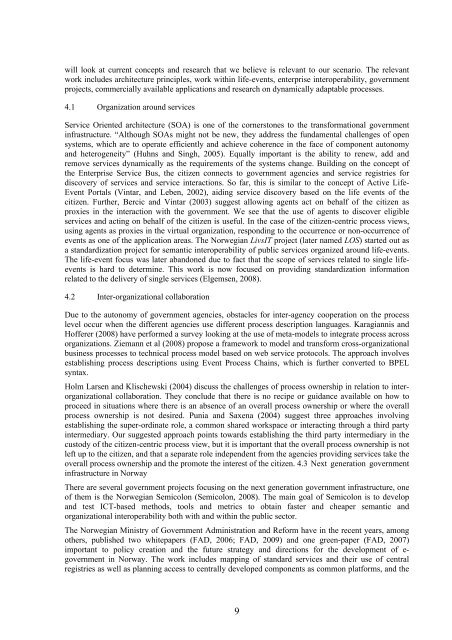Multi-channel provisioning of public services - Department of ...
Multi-channel provisioning of public services - Department of ...
Multi-channel provisioning of public services - Department of ...
You also want an ePaper? Increase the reach of your titles
YUMPU automatically turns print PDFs into web optimized ePapers that Google loves.
will look at current concepts and research that we believe is relevant to our scenario. The relevant<br />
work includes architecture principles, work within life-events, enterprise interoperability, government<br />
projects, commercially available applications and research on dynamically adaptable processes.<br />
4.1 Organization around <strong>services</strong><br />
Service Oriented architecture (SOA) is one <strong>of</strong> the cornerstones to the transformational government<br />
infrastructure. “Although SOAs might not be new, they address the fundamental challenges <strong>of</strong> open<br />
systems, which are to operate efficiently and achieve coherence in the face <strong>of</strong> component autonomy<br />
and heterogeneity” (Huhns and Singh, 2005). Equally important is the ability to renew, add and<br />
remove <strong>services</strong> dynamically as the requirements <strong>of</strong> the systems change. Building on the concept <strong>of</strong><br />
the Enterprise Service Bus, the citizen connects to government agencies and service registries for<br />
discovery <strong>of</strong> <strong>services</strong> and service interactions. So far, this is similar to the concept <strong>of</strong> Active Life-<br />
Event Portals (Vintar, and Leben, 2002), aiding service discovery based on the life events <strong>of</strong> the<br />
citizen. Further, Bercic and Vintar (2003) suggest allowing agents act on behalf <strong>of</strong> the citizen as<br />
proxies in the interaction with the government. We see that the use <strong>of</strong> agents to discover eligible<br />
<strong>services</strong> and acting on behalf <strong>of</strong> the citizen is useful. In the case <strong>of</strong> the citizen-centric process views,<br />
using agents as proxies in the virtual organization, responding to the occurrence or non-occurrence <strong>of</strong><br />
events as one <strong>of</strong> the application areas. The Norwegian LivsIT project (later named LOS) started out as<br />
a standardization project for semantic interoperability <strong>of</strong> <strong>public</strong> <strong>services</strong> organized around life-events.<br />
The life-event focus was later abandoned due to fact that the scope <strong>of</strong> <strong>services</strong> related to single lifeevents<br />
is hard to determine. This work is now focused on providing standardization information<br />
related to the delivery <strong>of</strong> single <strong>services</strong> (Elgemsen, 2008).<br />
4.2 Inter-organizational collaboration<br />
Due to the autonomy <strong>of</strong> government agencies, obstacles for inter-agency cooperation on the process<br />
level occur when the different agencies use different process description languages. Karagiannis and<br />
H<strong>of</strong>ferer (2008) have performed a survey looking at the use <strong>of</strong> meta-models to integrate process across<br />
organizations. Ziemann et al (2008) propose a framework to model and transform cross-organizational<br />
business processes to technical process model based on web service protocols. The approach involves<br />
establishing process descriptions using Event Process Chains, which is further converted to BPEL<br />
syntax.<br />
Holm Larsen and Klischewski (2004) discuss the challenges <strong>of</strong> process ownership in relation to interorganizational<br />
collaboration. They conclude that there is no recipe or guidance available on how to<br />
proceed in situations where there is an absence <strong>of</strong> an overall process ownership or where the overall<br />
process ownership is not desired. Punia and Saxena (2004) suggest three approaches involving<br />
establishing the super-ordinate role, a common shared workspace or interacting through a third party<br />
intermediary. Our suggested approach points towards establishing the third party intermediary in the<br />
custody <strong>of</strong> the citizen-centric process view, but it is important that the overall process ownership is not<br />
left up to the citizen, and that a separate role independent from the agencies providing <strong>services</strong> take the<br />
overall process ownership and the promote the interest <strong>of</strong> the citizen. 4.3 Next generation government<br />
infrastructure in Norway<br />
There are several government projects focusing on the next generation government infrastructure, one<br />
<strong>of</strong> them is the Norwegian Semicolon (Semicolon, 2008). The main goal <strong>of</strong> Semicolon is to develop<br />
and test ICT-based methods, tools and metrics to obtain faster and cheaper semantic and<br />
organizational interoperability both with and within the <strong>public</strong> sector.<br />
The Norwegian Ministry <strong>of</strong> Government Administration and Reform have in the recent years, among<br />
others, published two whitepapers (FAD, 2006; FAD, 2009) and one green-paper (FAD, 2007)<br />
important to policy creation and the future strategy and directions for the development <strong>of</strong> e-<br />
government in Norway. The work includes mapping <strong>of</strong> standard <strong>services</strong> and their use <strong>of</strong> central<br />
registries as well as planning access to centrally developed components as common platforms, and the<br />
9
















